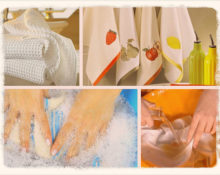Heat treatment is the best way to get rid of various pathogens that strive to penetrate the culinary domain. Boiling also helps get rid of stubborn stains that appear on kitchen towels with enviable frequency. But if you don’t follow a number of rules, you can easily turn your irreplaceable assistants into unsightly rags.
The best stain and grease removers
Since the invention of washing powders and bleaches, laundry soap has gradually been replaced by them. But in vain. After all, in the battle for the cleanliness of kitchen towels, it is difficult to replace it. It’s just important to understand that only blocks marked 72% minimum are suitable for these purposes.

The next in the ranking of reliable helpers in the fight against stains are:
- salt;
- soda (baking and ash);
- vinegar;
- lemon acid;
- potassium permanganate;
- sunflower oil.
Vegetable fat significantly increases the effectiveness of other products, especially when it comes to adding it to hot water.
Hydrogen peroxide and boric acid are also sometimes used for bleaching, and silicate glue is used for removing stains. But due to the high risk of damaging the towel, it is not recommended to exceed the dosage of these products indicated in the advice.
How and what to boil
A high-quality kitchen towel should absorb moisture well, dry quickly, and it simply must not leave lint on everything it comes into contact with. White waffle sheets cope well with these tasks. They also have one more feature - the ability to withstand repeated boiling without destroying the fibers.

But what chef wouldn’t want to decorate his premises with bright, colorful and perhaps even terry towels? Such a small touch can transform a kitchen. And add hassle. After all, colored fabrics do not tolerate boiling well. And the looped pile also reluctantly gives off odors with dirt. Therefore, to care for such materials, you need to master the high-temperature soaking technique.
Boiling
This involves keeping things soaked in the active substance for a long time (25–60 minutes) over low heat. One of the most popular recipes is a mixture of washing powder, dry bleach and vegetable oil - 2 tbsp each. l. ingredients for 5 l. hot water. After bringing the solution to a boil, kitchen towels are immersed in it and kept on fire for approximately 30 minutes. Then turn off the stove and wait until the water cools completely. Usually, during this time, even old stains have time to disappear and the fabric can only be rinsed thoroughly.

Baking soda copes just as well with stains. For a small number of fresh stains, it is enough to boil the towels in a solution of 1 glass of this substance diluted in 2 liters. water.It is better to pre-treat old and difficult to remove stains with soda slurry, which is kept on a towel for 30 minutes after application. If the product does not remove the stains, before the next wash it is best to soak the fabric overnight in a solution of a mixture of washing powder and soda ash (2 tablespoons per 3 liters of water).
Hot soak
This involves immersing kitchen towels in boiling water and then “infusing.” The most popular method involves two-stage processing. First, the stains are moistened with citric acid (20 g per glass of water), and the towel is left in a plastic bag for 3 hours. Then they are soaked in a mixture of 5 liters. boiling water and 10 drops of dark pink solution of potassium permanganate for 6 hours. An equally effective alternative is 3 tbsp. l. table salt and 2 tbsp. l. hydrogen peroxide diluted in the same amount of hot water. The soaking period is similar.
Simply ironing the items before sending them to the kitchen can increase the interval between high-temperature treatments of towels. The whole secret is that straightened fibers absorb and retain dirt less.


 0
0





